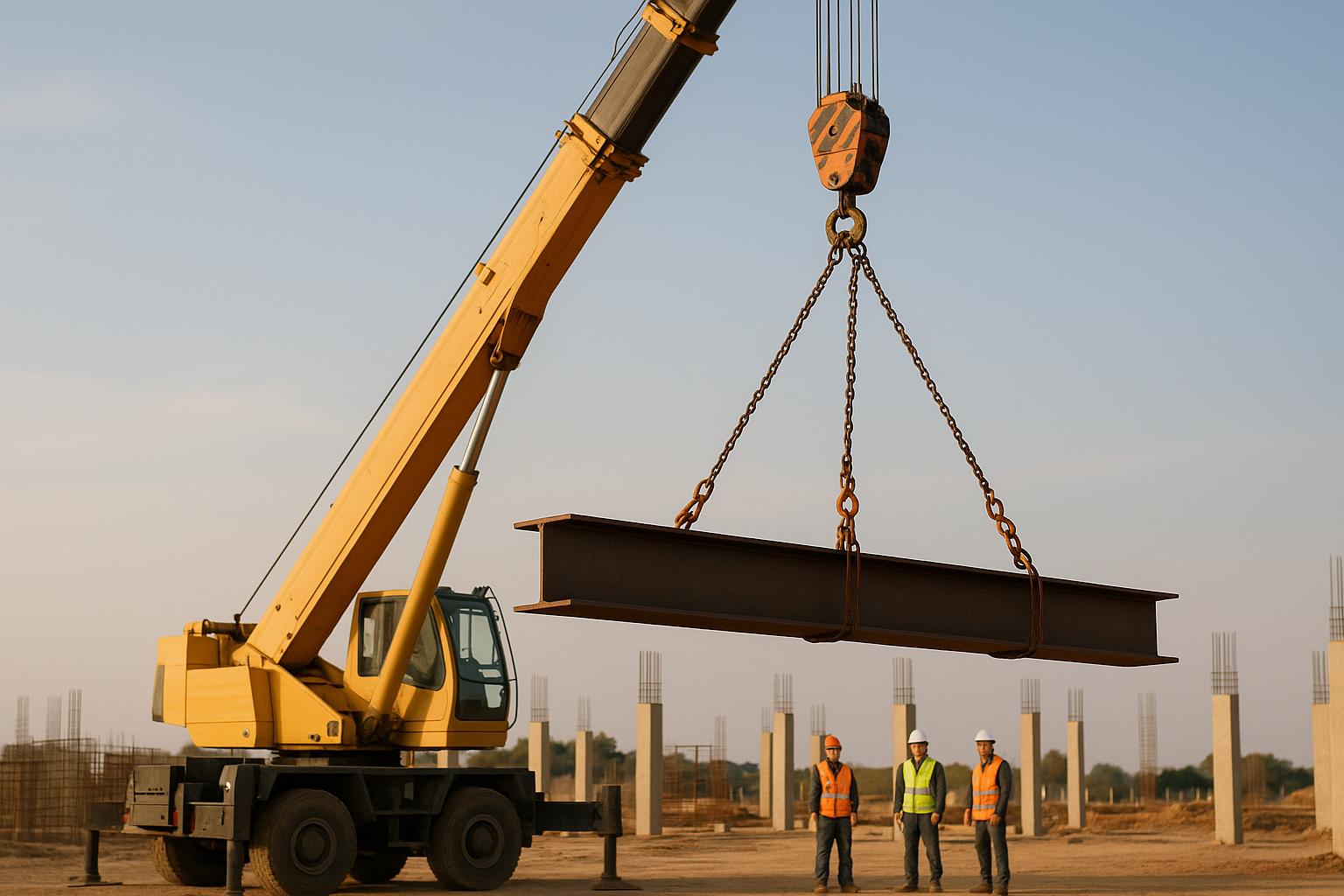How to Calculate Crane Lifting Capacity Safely

Calculating crane lifting capacity is all about precision and safety. Here’s what you need to know upfront:
- Key Factors: Load weight, boom length, boom angle, load radius, and crane setup all impact capacity.
- Load Radius Rule: As the load moves farther from the crane’s center, capacity decreases significantly.
- Environmental Impact: Wind, ground stability, and extreme temperatures can reduce lifting capacity by up to 20%.
- Safety Margins: Always ensure the crane’s rated capacity exceeds the total load by at least 25%.
- Load Charts: These are your go-to tools for determining safe lifting limits based on crane configuration.
Bottom Line: Proper calculations, pre-lift inspections, and adherence to safety protocols prevent accidents, protect workers, and ensure operations run smoothly. Let’s dive deeper into the steps and considerations for safe crane operations.
How To Read Load chart || How To Calculate Crane Capacity As Per Load Chart || Crane Load Chart
Main Factors That Affect Crane Lifting Capacity
Understanding the factors that influence a crane's lifting capacity is essential for making safe and efficient decisions during operations. Each of these elements plays a key role in determining how much weight a crane can handle at any given time.
Load Weight
The starting point for any lift calculation is the load weight. This includes not only the primary object being lifted but also the weight of any rigging equipment, such as slings, hooks, or lifting beams. For example, lifting a steel beam weighing 8,000 lbs might require an additional 500 lbs of rigging gear, bringing the total weight to 8,500 lbs.
To ensure accuracy, operators should use certified scales or load cells, as manufacturer specifications might not account for modifications, attachments, or even moisture absorption. While engineering drawings or manufacturer specs can provide a baseline, they often miss these real-world variables.
It's critical to ensure the crane's rated capacity exceeds the total lifted weight by a safe margin. Most operations apply a safety factor of at least 25%. This means, for instance, a 10,000 lb load should only be lifted by a crane rated for at least 12,500 lbs at the working radius.
From here, the geometry of the lift becomes a crucial consideration.
Boom Length, Angle, and Load Radius
The crane's lifting capacity is heavily influenced by three interconnected factors: boom length, boom angle, and load radius.
- Boom length is the total extended length of the crane's boom, measured in feet.
- Boom angle refers to the angle between the boom and the ground.
- Load radius is the horizontal distance from the crane’s center of rotation to the center of the load.
As the load radius increases, the crane's lifting capacity drops significantly. For example, a mobile crane capable of lifting 50,000 lbs at a 10-foot radius might only manage 15,000 lbs at a 50-foot radius. A steeper boom angle increases lifting capacity but reduces reach, while a lower angle allows for greater reach but decreases capacity.
It's also important to note that the load radius can change during the lift. For instance, a lift that starts at a 30-foot radius at ground level might shift to a 25-foot radius as the load is raised. Operators must calculate the crane's capacity based on the maximum radius encountered during the operation.
While load weight and geometry are critical, external conditions can also significantly impact crane performance.
Crane Setup and Weather Conditions
Proper setup is essential for maximizing a crane's capacity. Fully extended outriggers on stable, level ground are ideal, as partially extended outriggers or uneven terrain can reduce capacity by 20% or more. When working on soft or uneven ground, operators should use timber mats or steel plates to stabilize the crane. The ground must be able to support not just the crane's weight but also the additional forces generated during lifting.
Wind speed is another critical factor, particularly for loads with large surface areas. Most crane manufacturers specify maximum wind speeds for safe operation, typically between 20 and 30 mph. For example, a large prefabricated wall panel can create significant wind resistance, destabilizing both the crane and the load.
Extreme temperatures also come into play. Hydraulic systems and steel components can be affected, with capacity potentially reduced by up to 15% in temperatures below 0°F or above 100°F. Many operators adjust by reducing lifting capacity by 10-15% in these conditions.
Finally, carefully configuring counterweights can help optimize lifting capacity while maintaining safety throughout the operation.
How to Read Crane Load Charts
Crane load charts take all the critical factors affecting crane capacity and turn them into practical, easy-to-use data for each operation. While they might seem confusing at first, their format is consistent, and once you grasp the basics, they become much easier to interpret.
Reading Load Chart Information
Every load chart is designed for a specific crane setup. To find the maximum lifting capacity, you need to use the chart that matches your crane's configuration. This includes details like the boom length range, counterweight setup, outrigger positioning, and the crane's rotation angle.
The chart itself is typically laid out as a grid. Across the top, you'll find the boom lengths, while the left-hand side lists the load radius. Where these two values intersect, you'll see the crane's maximum lifting capacity (given in pounds or tons) and the recommended boom angle in parentheses. For instance, if you're working with a 60-foot boom at a 30-foot radius, the chart might show a capacity of 25,000 lbs with (45°) beneath it. This means the crane should be set at a 45° boom angle to safely handle that load.
It's important to note that these capacity figures are based on ideal conditions, such as firm, level ground and properly deployed outriggers. As the boom length increases or the load radius grows, the crane's capacity decreases. This foundational understanding is crucial when interpreting load charts and avoiding mistakes.
"Understanding load charts is not just a requirement for crane operators; it's a fundamental aspect of ensuring a safe working environment and optimizing the crane's performance." – Alltracon Machinery Moving and Millwright Services
Common Load Chart Mistakes
Even when you know how to read a load chart, there are common errors that can lead to unsafe operations. One frequent mistake is using a chart that doesn't match the crane's current setup. This can lead to an overestimation of capacity, creating serious safety hazards.
Another factor to keep in mind is the environment. Load charts assume perfect conditions, but real-world factors like wind or uneven ground can significantly reduce a crane's actual capacity. Always evaluate the environmental conditions alongside the load chart before beginning any lift.
sbb-itb-6be7c12
Step-by-Step Lifting Capacity Calculation
Understanding how to calculate a crane's lifting capacity is essential for ensuring safe and efficient operations. Each step builds on the previous one, guiding you through the process.
Step 1: Measure Load Weight and Distance
Start by determining the total weight of the load, recorded in pounds or tons. Then measure the horizontal distance from the crane's rotation center to the load, also known as the load radius. Use tools like a tape measure or a laser distance tool for accurate measurements. To ensure reliability, cross-check these figures with certified scales or the specifications provided by the manufacturer.
Step 2: Determine Boom Length and Angle
Next, measure the boom length, which is the distance from the crane's pivot point to the load block, recorded in feet. Also, note the boom's angle in degrees relative to the horizontal plane. These factors are crucial because changes in boom length and angle directly impact the crane's lifting capacity. For instance, a longer boom or a lower angle typically reduces the capacity at a specific load radius. To optimize safety, position the crane to use the shortest boom length necessary for the lift.
With these details in hand, you’re ready to consult the load charts for verification.
Step 3: Consult Load Charts
Using the measurements you've gathered, refer to the appropriate load chart for your crane's specific configuration. Match the boom length and load radius to the chart to find the maximum lifting capacity under those conditions. It’s important to apply the manufacturer's safety factor to the capacity values listed on the chart. If your setup is close to the chart's limits, consider repositioning the crane or modifying its configuration to provide an extra margin of safety.
Step 4: Assess Weather and Ground Conditions
Environmental factors can significantly influence a crane's performance and safety. Use this checklist to account for external conditions:
- Ensure the crane is set up on stable, level ground with fully deployed outriggers.
- Evaluate wind conditions and apply any necessary capacity reductions as specified by the manufacturer.
- Check that the load is evenly balanced to avoid uneven weight distribution.
- Consider how temperature might affect equipment performance, following the manufacturer's guidelines.
Safety Practices and Compliance Requirements
Following strict safety practices and meeting compliance standards ensures the protection of workers, equipment, and the worksite while adhering to legal lifting regulations.
Pre-Lift Safety Inspections
Every crane operation starts with a thorough pre-lift inspection, focusing on both equipment and environmental conditions. Inspect the crane’s structural components, such as cables, hooks, and load blocks, for any signs of wear or damage. Verify that all safety devices are functioning properly and have up-to-date calibration records.
Make sure outriggers are fully extended on solid, level ground with proper float pads, keeping the crane within a 1% grade tolerance (approximately 0.5°). Wind conditions should be monitored continuously; operations must stop if wind speeds exceed 20 mph. Use a calibrated anemometer to take readings every 10 minutes.
Perform a trial lift by raising the load about 6 inches and holding it steady for 30 seconds. This step helps identify any stability issues before proceeding with the full lift.
To ensure safety, all personnel should stay clear of the load path and swing radius. Establish clear communication protocols using standardized hand signals or radio systems, and have backup communication methods ready in case the primary system fails.
Once the inspections confirm that everything is in order, complete the necessary documentation before moving forward with the operation.
Required Documentation
Proper documentation is not just a regulatory requirement but also a vital safety measure for crane operations. OSHA regulations under 29 CFR 1926 Subpart CC specify detailed record-keeping practices for lifting activities.
Prepare a detailed lift plan that includes key details like the load weight, dimensions, center of gravity, planned lift path, and potential obstacles or hazards. Document the crane’s configuration, including boom length, load radius, and capacity calculations, referencing the manufacturer’s load charts. Note weather conditions during planning and include provisions for monitoring changes.
Daily inspection records for critical components and safety systems are essential. Use U.S. standard units for measurements and ensure the inspector’s name, certification number, and signature are included on each report.
Maintain operator certification records to confirm that all personnel involved are properly certified. OSHA requires crane operators to hold valid certifications from accredited organizations, and these records must be readily available for inspection.
Load chart verification is another crucial part of the documentation. Include the specific load chart used, details of the crane’s configuration, and calculated capacity margins. Record actual load weights using certified scales whenever possible, and document any estimated weights along with the methods used to calculate them. Include safety factors and adjustments for environmental conditions.
Federal regulations require all documentation to be kept for at least three years. Copies must be accessible at the job site during operations. Digital records are acceptable as long as they can be accessed immediately and printed upon request.
Additionally, maintain equipment maintenance records to show that the crane has been serviced according to the manufacturer’s recommendations. Include records of any repairs or modifications, as well as calibration records for load moment indicators, scales, and other measuring devices used during operations.
Summary
Safely calculating crane lifting capacity requires a mix of technical expertise and strict adherence to safety protocols. It starts with understanding the key factors that influence lifting capacity: load weight, boom length and angle, load radius, and crane configuration.
Manufacturers provide load charts that outline safe lifting limits based on the crane's configuration and rated capacities. These charts detail capacity ratings at different boom angles and load radii, showing how capacity typically decreases as the boom extends or the load moves farther from the crane's center. These charts are essential tools for planning and executing lifts safely.
To ensure accurate and safe operations, follow a systematic process: measure the load and its distance, determine the boom's dimensions, and consult the load chart to verify the crane's capacity. Additionally, external factors like wind must be considered, as they can significantly affect operational safety.
Regulatory compliance is critical, requiring thorough documentation of lift plans, pre-lift inspections, and operator certifications. On-site, you need to maintain detailed inspection records, load chart verifications, and regulatory documentation to meet these standards. Beyond calculations, hands-on inspections are vital for ensuring safe operations.
Before lifting, conduct pre-lift safety checks to confirm stable ground conditions and proper equipment setup. Avoid operating at the crane's rated maximum capacity by incorporating safety margins to account for unexpected forces or changing conditions.
Ultimately, calculating crane lifting capacity is more than just a technical exercise - it’s a vital safety measure. When done correctly, these calculations create a foundation for secure and efficient lifting operations, ensuring the safety of everyone involved on the job site.
FAQs
How do wind and temperature affect a crane's lifting capacity?
Wind and temperature are key factors that directly influence a crane's lifting capacity and safety. Strong winds can exert extra force on both the crane and its load, which can compromise stability. For instance, when wind speeds exceed 20 mph, the risks of tipping or swaying loads dramatically increase - this is especially true for larger loads or when using extended booms.
Temperature extremes also pose challenges. Hot weather can thin hydraulic fluids, which affects their performance, while cold temperatures can make steel components brittle and place extra stress on hydraulic systems. In freezing conditions, cranes may need to reduce their load capacity by 25-40% to maintain safe operation. Keeping a close eye on weather conditions and adjusting operations accordingly is essential for maintaining both safety and efficiency.
What are some common mistakes operators make with crane load charts, and how can they avoid them?
Crane operators sometimes misinterpret crucial details on load charts, such as boom length, load radius, or boom angle, which can result in miscalculating load capacities. These mistakes can lead to dangerous situations like overloads, instability, or even accidents. Errors often stem from misjudging measurements or overlooking specific crane configurations.
To minimize these risks, it’s essential to thoroughly review the load chart. Take time to understand all symbols, measurements, and capacity limits. Double-check your calculations for boom length and radius, and always adhere to the specified parameters for your crane’s setup. Proper training and a sharp focus on details are key to maintaining safety and ensuring smooth operations.
Why is it important to include a safety margin when calculating a crane's lifting capacity, and how can it be applied?
Including a safety margin when determining a crane's lifting capacity is crucial to handle unforeseen challenges like wind, uneven terrain, or slight errors in estimating the load's weight. This precaution minimizes the risk of overloading, which could result in accidents, damage to equipment, or delays in operations.
To implement a safety margin, you reduce the crane's maximum rated capacity by a certain percentage - usually between 10% and 25%, depending on the type of crane and the specific working conditions. This buffer helps ensure operations remain safe and dependable, even when conditions aren't perfect.
Related Blog Posts
Blogs, calculators, and other content on the TDS blog is for educational purposes only and does not constitute crane or rigging advice. For information specific to your situation, please contact us for an estimate or consultation.
Related Articles

5 Essential Crane Safety Tips for Construction Sites
Learn essential crane safety tips to prevent accidents and ensure safe operations on construction sites, protecting both workers and equipment.

Pre-Lift Safety Checklist for Crane Operations
Explore essential pre-lift safety checks to ensure safe crane operations and minimize risks on site.

How to Match Equipment Rentals to Project Needs
Learn how to effectively match equipment rentals to your project needs, ensuring safety, efficiency, and budget adherence throughout.
